test
HTIRC E-NEWSLETTER
Fall and Winter 2019
Volume 12 Issue 1
Articles in this issue
- Conservation Programs Offer Protective Fencing for Tree Planting Establishment
- HTIRC Plot Demonstrates Increased Black Walnut Growth After Thinning
- HTIRC Seed Collection and Distribution for 2019
- Lidar Technology is a Tool to Compliment Forest Management and Monitoring
- Tackling resistance breeding to restore butternut
- Invasive Pests Kill so Many Trees Each Year, it’s Equal to 5 Million Car Emissions
- HTIRC Scientists Participate in Summer Research Program
- HTIRC Releases the First Annual Report
- HTIRC Student and Staff Awards
- Access HTIRC Research and Management Publications at our Website
Welcome to this issue of the Hardwood Tree Improvement and Regeneration Center E-newsletter. We have a new website and associated newsletter format that we hope you will enjoy and find useful.
The HTIRC is committed to enhancing the productivity and quality of Central Hardwood Region trees and forests for the economic and environmental benefits they provide. Scientists at the HTIRC are using conventional tree improvement breeding as well as molecular and genetic technologies to improve the wood quality, growth characteristics, and insect and disease resistance of trees like black walnut, black cherry, red and white oaks, butternut and American chestnut. Research in tree breeding, tree nursery practices, tree plantation establishment and management, and Central Hardwoods silvicultural systems is aimed at increasing the regeneration success rate for high quality hardwood trees and forests.
We invite you to read about some of our activities by visiting the E-Newsletter Page at: https://htirc.org//resources/newsletters/
If you wish to download the pdf version and your web browser is Internet Explorer, we recommend you first download Adobe Acrobat Reader DC at https://get.adobe.com/reader/ for the newsletter format to appear correctly on your screen.
Conservation Programs Offer Protective Fencing for Tree Planting Establishment
Some midwestern states now have access to an additional tool to aid in establishing hardwood tree plantings. The USDA Natural Resources Conservation Service (NRCS) has added protective fencing to tree planting and natural regeneration for some hardwood establishment practices in the Environmental Quality Incentives Program (EQIP). Based on HTIRC research and demonstration plantings comparing fenced to unfenced plantings, deer exclusion fencing provides significant benefits for hardwood tree establishment, growth, and stem quality development. Fencing can also be less expensive than tree tubes or other individual tree protection techniques as the area of planting increases.
The NRCS in some states has also used the Purdue/HTIRC publication How to Build a Plastic Mesh Deer Exclusion Fence as design and construction guidance for the protection practice.
You can check the EQIP practices and payment rates for your state at: https://www.nrcs.usda.gov/wps/portal/nrcs/detail/national/programs/financial/?cid=nrcseprd1328426
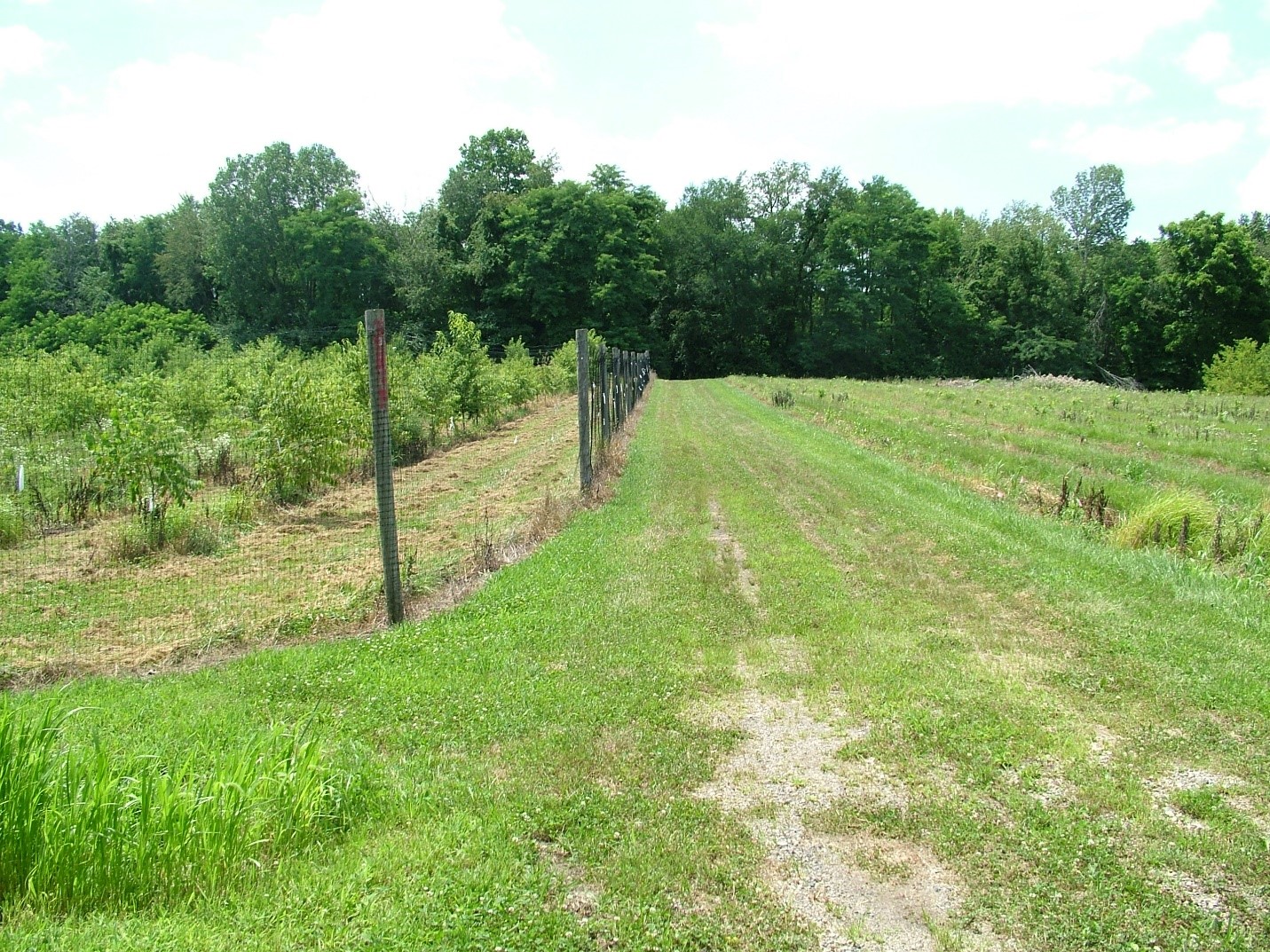 Fenced and unfenced red and white oak, black cherry and black walnut plantings during the third growing season.
Fenced and unfenced red and white oak, black cherry and black walnut plantings during the third growing season.
HTIRC Plot Demonstrates Increased Black Walnut Growth After Thinning
by Caleb Kel, HTIRC Research Forester
In 2003, the HTIRC established a black walnut planting at the Rodecker home in Fishers, Indiana. Four hundred half-sibling (progeny from a single mother tree) sprouted seeds were planted in five blocks of 80 trees at an 8’x8’ spacing to compare with five commercial and two improved seed populations. Tree #226 has turned out to be an improved timber parent: its offspring have good timber form and growth rate. With no major site variations or genetics to contend with, this planting is ideal for testing a black walnut plantation’s thinning response.
The thinning prescription approximated a checkerboard pattern in the interior while leaving the border trees (white pine), unthinned, removing about 3/8th’s of trees in each thinned block (Figures 1 and 2) at 11 years. Three of the five blocks in the plantation were thinned, with two left untreated as a control. Five years later, in the winter of 2018 – 2019, the planting was measured for timber quality, diameter, and merchantable height at 16 years of age.
The gains in diameter growth were significant, increasing average diameter growth 17% in the thinned blocks to 0.34 in/yr. compared to 0.29 in/yr. annual DBH growth in the control (Figure 3). While this difference may appear small, it is enough to shorten the rotation length (for a stand average 20-inch DBH) in the thinned blocks to 59 years versus 69 years for the unthinned blocks. No significant differences were found in merchantable height or timber quality, which is likely a result of the shared ancestry of these trees and the consistency of the soil. Controlling both of these variables has been a challenge in black walnut timber research.
Of course, gains from thinning will vary between sites and depend on how much and when a landowner actually thins a plantation. While only diameter growth improved at this planting, a gain in quality and merchantable height would be expected for seedling plantations and more variable sites. In the future, the HTIRC will also report on selective thinnings performed on 10- and 11-year black walnut plantings at the Southeast Purdue Agricultural Center.
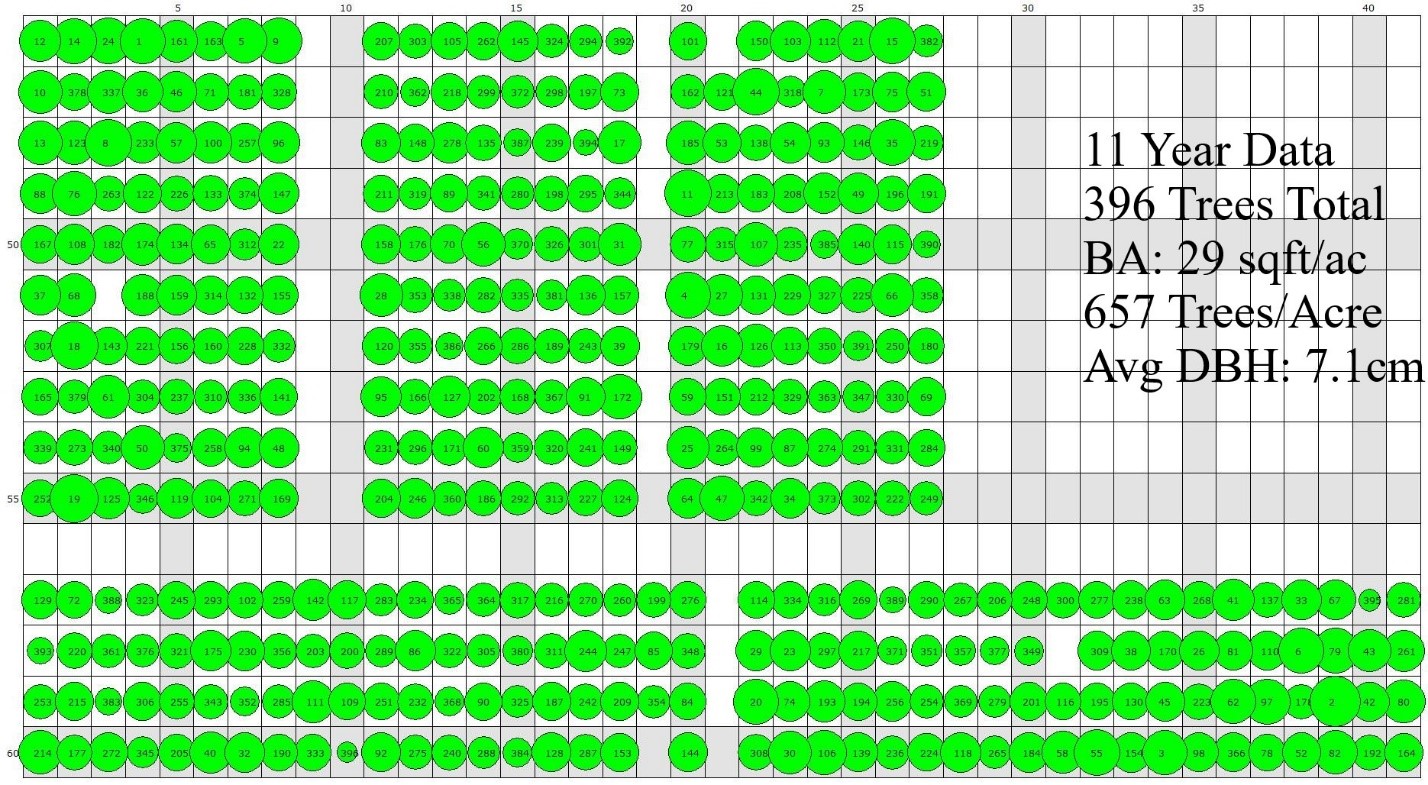
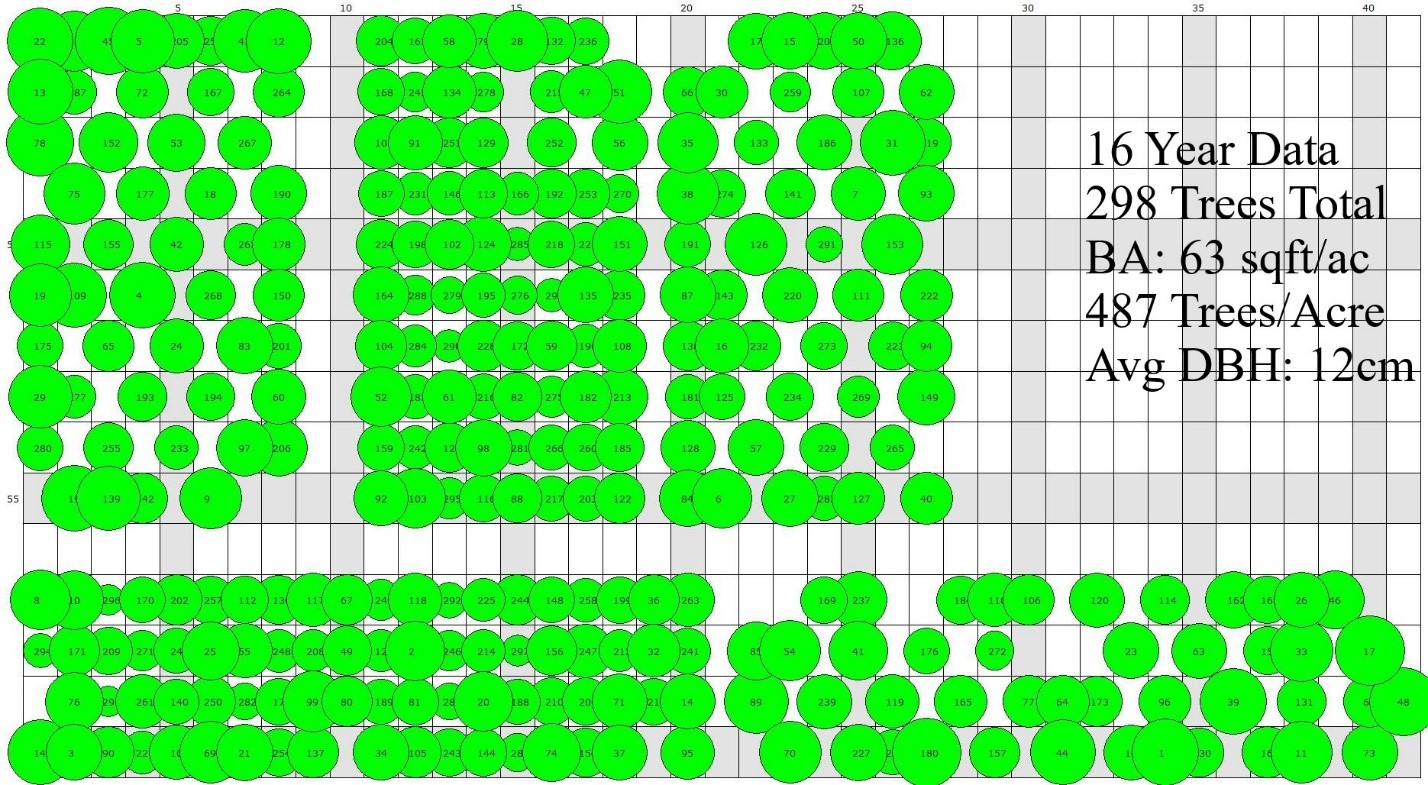 Figure 2-Post-thinning distribution of trees at 15 years of age in 2018. (Size of each circle reflects the DBH and timber quality of each tree)
Figure 2-Post-thinning distribution of trees at 15 years of age in 2018. (Size of each circle reflects the DBH and timber quality of each tree)
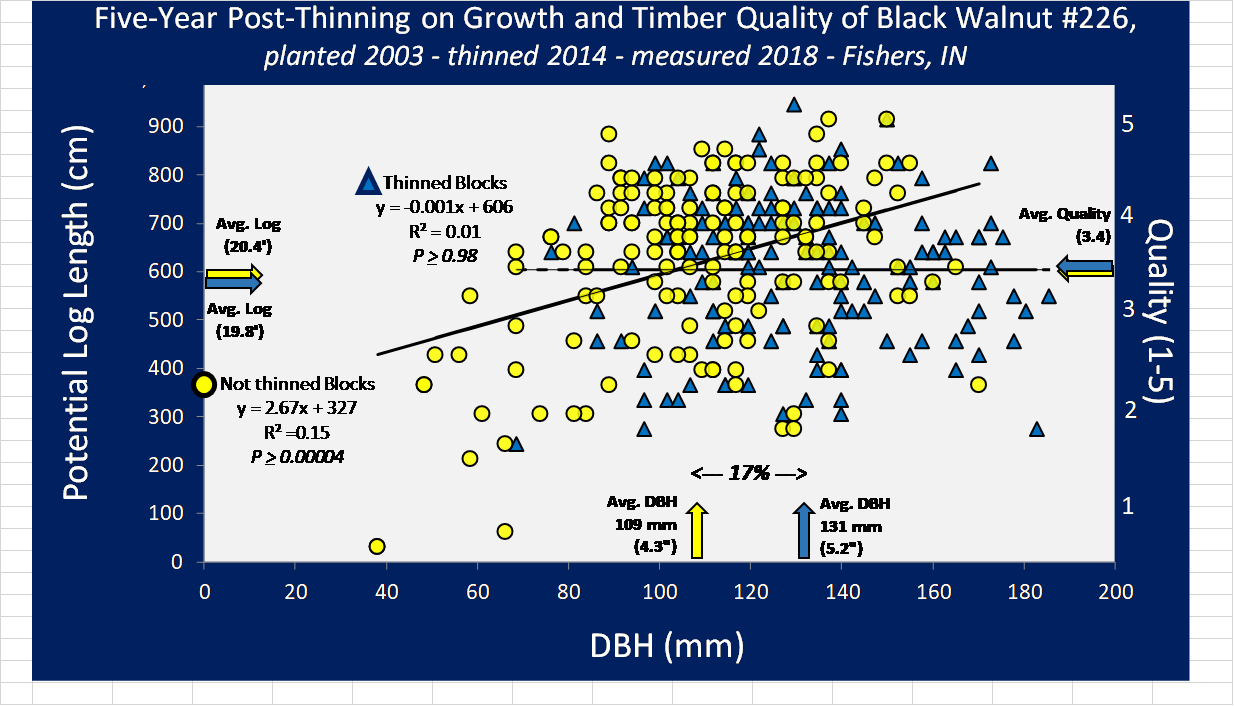
HTIRC Seed Collection and Distribution for 2019
By Jim McKenna and Caleb Kell
2019 HTIRC seed harvest totals are presented below along with distribution to our cooperators and principal investigators. Our chestnut crosses consisted of new F1 (first generation) hybrids of American by Chinese and new pure American crosses with SUNY (State University of New York) and Indiana HTIRC fresh and frozen pollen. Ten trees were crossed and frozen pollen of both Chinese and American chestnut survived and pollinated well, validating our pollen storage protocols to aid future breeding. Hensler Nursery, Hamlet, IN, has continued growing pure American chestnuts from our Duke American orchard and IN-The American Chestnut Foundation members.
We harvested select cherry seed from our three oldest breeding orchards planted in 2005 and 2006 and our 2007 clone bank at the Martell Forest and Lugar Farm. This was the first year that all four plots produced a good crop with most clones setting seed. We provided 35,000 select cherry seed to the IN-DNR Vallonia Nursery and have nearly 150,000 seed on hand to store. Preliminary research we have done shows that cherry can be stored for at least 7 years in a conventional freezer when dried down to 5% moisture content. Over 20,000 seed were sown at Vallonia to provide progeny and provenance test material for 2021.
Brian Beheler, Purdue FNR Farm Manager, and Martell Forest staff and students picked up over 12,000 bed-run black walnuts for the IN-DNR Vallonia nursery and over 7,000 select seed and progeny test seed for HTIRC research.
Our butternut seed orchards, in partnership with the U.S. Forest Service, Wayne and Hoosier National Forests (planted 2012-’13), produced nearly 5,000 seed in total. Our Walla Walla, WA orchard, in cooperation with Nelson Irrigation, (planted 2007) produced 6,844 pure butternuts. We have arranged for the Clements Nursery (West Virginia Division of Forestry) to grow and distribute these again. Clements first pure butternut crop grew very well and will be available spring of 2020.
Nearly 3,000 hybrid butternut and pure selections from our new orchard at the Pinney Purdue Agricultural Center (planted 2011-‘13) and Martell butternut canker screening block ( planted 2003-’04) makes the HTIRC’s first substantial harvest of such seed. Additional pure butternut seed, some likely pollinated from hybrids, will be used for research and excess seed will be provided to nutgrower associations.
While our two grafted white oak orchards at Purdue produced no seed this fall, both had seedling rootstocks that were grafted this year with 13 new clones from our Edinburgh, IN, Danzer Forestland seed orchard. One new elite selection was added into these, and those clones with just 1 or 2 trees were increased. About 60 trees in all were bark grafted May – June 2019, and both orchards are now fully stocked.
Plantings done with our many cooperators and partners makes this level of seed production and distribution possible. We thank them for their assistance!
|
HTIRC Tree Improvement 2019 Seed Harvest and Distribution of Seed |
||||
| Common Name | Species | Purpose / Orchard – Provider | No. Seed | Nursery / Plot Info |
| American Chestnut | Castanea dentata | Wildlife Research | 930 | HTIRC / OSU |
| American Chestnut | Castanea dentata | Controlled Crosses | 1,171 | HTIRC / TACF |
| American Chestnut | Castanea dentata | Conservation – IN-TACF – HTIRC | 1,100 | Hensler Inc. / IN-TACF |
| Hybrid Chestnut | Castanea dentata | Conservation – IN-TACF – HTIRC | 1,075 | IN-TACF / HTIRC/ TACF (RS) |
| Black Cherry | Prunus serotina | Select – HTIRC Seed Orchards | 35,000 | IN DoF Vallonia |
| Black Cherry | Prunus serotina | Elite Progeny Test – HTIRC | 25,000 | HTIRC |
| Black Cherry | Prunus serotina | Elite Progeny Long-Term-Storage | 150,000 | HTIRC / USDA FS |
| Black Walnut | Juglans nigra | Bed-Run – HTIRC | 12,000 | IN-DNR DoF Vallonia |
| Black Walnut | Juglans nigra | Regional & Family Genetics | 4,897 | Jacobs, Physiology |
| Black Walnut | Juglans nigra | 1/2 Sib Families | 2,070 | Ginzel et al., Forest Health |
| Butternut | J. cinerea | Conservation Walla Walla, WA | 6,844 | WV DoF Clements |
| Butternut | J. cinerea | Conservation, Wayne NF OH | 600 | WV DoF Clements |
| Butternut | J. cinerea | Conservation, Hoosier NF IN – OFS | 4,400 | WV DoF Clements |
| Butternut HTIRC | J. cinerea* | Breeding/ Conservation/ Research | 2,757 | HTIRC / Hensler / TNC |
| Hybrid Butternut | J. Xcinerea** | Select – 2012 Subline II at Vallonia | 6,020 | IN DoF Vallonia |
| Hybrid Butternut | J. Xcinerea*** | Resistant PPAC – BNUT 1 | 2,900 | IN DoF Vallonia |
| White Oak | Quercus alba | Bed-Run / Select | 2,589 | Saunders, Silvics |
*Low percentage may be pollinated by hybrids.
**Promissing selections from 2003 disease screen. Complex hybrids HTIRC grafted trees (2012) at Vallonia.
***Most resistant families with upwards of 17-years survival under disease pressure. Complex hybrids.
Lidar Technology is a Tool to Compliment Forest Management and Monitoring
By Franklin Wagner
Have you ever wondered if traditional forest inventory techniques are missing something? While these methods can collect a wealth of information and data, measuring the three-dimensional structure of forest canopy trees can be a tricky and time-consuming task— but this structure influences functions such as productivity, nutrient cycling, and a forest’s ability to provide habitat. These are important considerations for forest regeneration, conservation, and timber production.
Lidar (Light Detection and Ranging) is a remote sensing technology that offers many benefits for forestry applications (Figure 1). By shooting thousands and millions of individual laser pulses, a lidar system can create a 3D map of the surrounding environment. Imagine, for example, that instead of walking to each individual tree in a forest stand to measure its diameter, you could set up a lidar system in a few places throughout the stand— or fly a lidar system overhead— and collect the same data quicker, and even more accurately. Lidar is advantageous for applications such as this as it can achieve higher resolutions than other remote sensing technologies and is able to penetrate through the canopy.
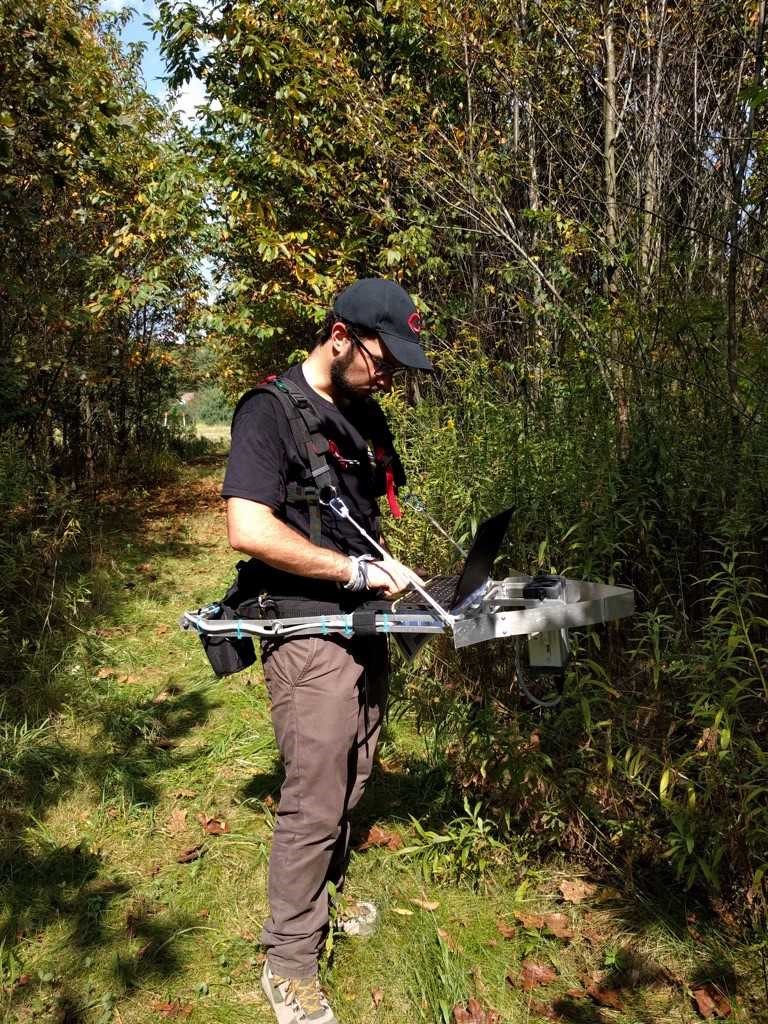
Many different types of lidar exist, both those operated on the ground and those operated in the air. Terrestrial lidar scanning (TLS) can achieve remarkable data resolution, measuring structural elements as fine as individual leaves and twigs, but is limited in its deployment across larger areas. The 2018 HTIRC Annual Report highlights ongoing work capitalizing on the capabilities of terrestrial lidar scanning (TLS). On the other hand, aerial lidar scanning (ALS) cannot achieve quite as detailed data but is able to be deployed across wider spatial extents. The range of spatial extents across which lidar data can be collected is important, as ecological patterns and processes also occur across a range of spatial (and temporal) scales. Lidar can be used for applications from identifying individual species and measuring individual allometries to identifying forest community types and measuring critical structure-function relationships, among other forestry-related tasks.
One type of aerial system that is seeing more frequent ecological use, and that could prove particularly useful for forest managers and landowners, is UAV drone operated lidar (Figure 2). UAV lidar, in some sense, combines the benefits of ALS and TLS and circumnavigates their shortcomings— it can be used at larger spatial scales than ground-based systems, but also has increased data resolution compared to plane flown lidar as a result of flying at much lower altitudes (Figure 3, 4).
Compared to TLS data collection that may take multiple days, data collection for a point cloud such as that presented in Figure 3 could reasonably be initiated and completed within a single hour. This portability and data quality can make UAV lidar an attractive and worthwhile investment for forest managers and landowners to use for monitoring the structural dynamics across a forest stand or property. For example, several flights throughout the growing season would be a quick and efficient way to accurately measure temporal dynamics of canopy structure and in turn forest health and functioning.

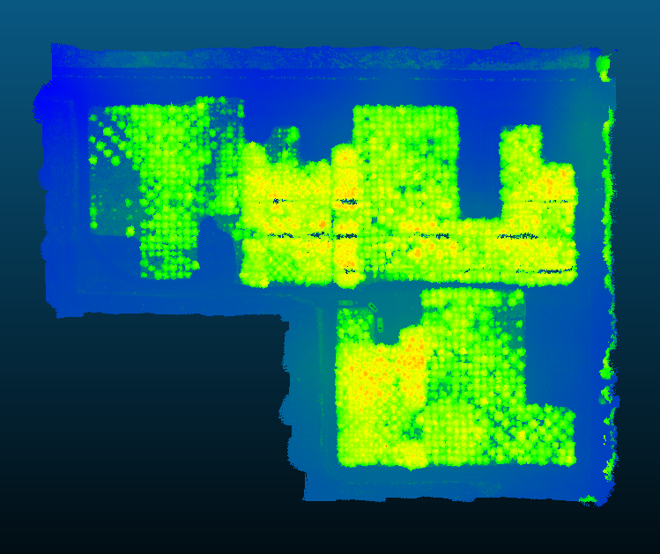 Figure 3. Top-down view of a UAV lidar point cloud collected at Martell Forest, Tippecanoe County, Indiana. Data points colored by height. Image provided by the Purdue Digital Photogrammetry Research Group.
Figure 3. Top-down view of a UAV lidar point cloud collected at Martell Forest, Tippecanoe County, Indiana. Data points colored by height. Image provided by the Purdue Digital Photogrammetry Research Group.
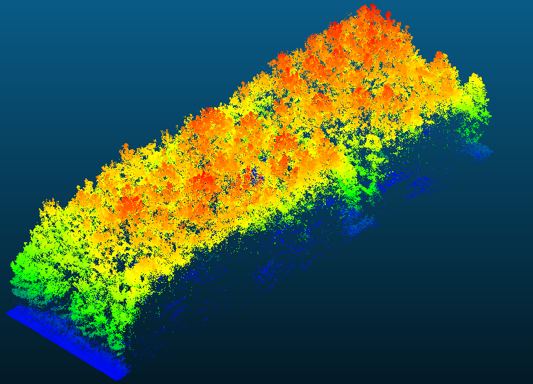
While UAV lidar brings along specific advantages, it is still limited in its ability to reach the lowest levels of the canopy, as exhibited in Figure 4. This is a result of what is known as optical occlusion- while lidar can penetrate multiple layers of the canopy, at some point the laser energy will be completely ‘saturated’, or used up, past which no data returns are possible. This also applies to ground-based systems, as they can exhibit a limited capacity to reach the upper canopy in dense forest stands. Therefore, making use of both UAV and terrestrial data can significantly increase the amount of information that can be extracted and utilized.
Much like UAV flights throughout a growing season could highlight structural dynamics, TLS scans at the beginning and end of a growing season would be an efficient means to measure annual growth and productivity. This would immensely cut down on time, labor, and financial resources compared to traditional stick and tape techniques, and furthermore reduces the physical environmental damage that often comes with such techniques (e.g. trampling understory vegetation).
This is not to say that lidar is an end-all be-all replacement for traditional forestry monitoring practices— while it may streamline some aspects of forest management, it should be used in tandem with tried-and-trued methods to ensure that management and conservation plans are as robust and comprehensive as possible. The physical structure of forests, and especially forest canopies, influences a great number of forest functions, patterns, and processes. Therefore, it makes sense for us to use all the tools at our disposal to incorporate these elements in forest management and monitoring.
Tackling resistance breeding to restore butternut
By Carrie Pike (USDA Forest Service, State and Private Forestry), James Jacobs (USDA Forest Service, Forest Health Protection) and Andrea Brennan (Purdue University, Forestry and Natural Resources Department)
Butternut, Juglans cinerea, is an uncommon, charismatic tree that was once revered for its myriad of uses: its nuts were prized for consumption, its wood valued for products such as bowls and cabinetry, and its husk was used as a fabric dye. In the late 1960s, land managers in Wisconsin began noticing a stem canker in association with dead and dying trees, a disease that was later reported across the entire range of butternut. The origin of this pathogen, Ophiognomonia clavigignenti-juglandacearum (Oc-j), is unknown. Butternuts’ gradual disappearance since those first sightings is now attributed to a combination of mortality caused by butternut canker, secondary pathogens, and losses in habitat: butternut thrives in mixed forests under high light and high disturbance regimes. In Canada, butternut is listed under SARA (Species At Risk Act), but it is currently not listed under the US Endangered Species Act. Instead, various states (Kentucky, Tennessee, New York and more recently Minnesota) have included butternut on state-based lists as “threatened,” “vulnerable,” or “of special concern.” The International Union for Conservation of Nature recently assessed butternut’s status and classified it as “endangered” in 2018.
Butternut naturally hybridizes with Japanese walnut, Juglans ailantifolia, which was introduced to the United States in the late 1800s. Hybrids between J ailantifolia and J cinerea may exhibit morphologic features of one or both species, and occupy a range of size classes from small saplings to large trees. Hybrid trees are more commonly found around former homestead sites, urban or community gardens, and as yard trees as opposed to forests that were not recently inhabited by people. Hybrids are not necessarily bad: hybrids tend to express higher levels of resistance to the pathogen than pure butternuts. Resistance is not necessarily guaranteed with hybrid stock, because genes in J ailantifolia that provide resistance to the Oc-j pathogen may not be transmitted to all the progeny. Many large trees identified for gene conservation turn out to be hybrids (after confirming with genetic analysis), even though they have many physical similarities to pure J cinerea. Natural selection is likely to continue favoring hybrid trees with improved resistance, with or without human interference. Scientists are interested in capitalizing on these natural hybrids as well.
For decades, butternut has frustrated scientists seeking to identify, and quantify, genetic resistance. A variety of techniques have been employed to screen seedlings and saplings but these efforts have largely failed to sort out genetically-based resistance among families, or genetic lines, of butternut. Further, butternuts are naturally “recalcitrant,” meaning that seeds cannot be stored for any length of time using standard protocols. As a result, gene conservation in the US has consisted primarily of planted, or “living,” clone banks, many of which eventually succumbed to the pathogen.
These challenges, and others, were addressed at a butternut workshop held July 15-16 2019 at Purdue’s Martell Forest. The meeting was focused on genetics: how scientists in the US and Canada may improve the effectiveness of breeding, screening, and conserving germplasm. In all, 19 scientists from public and private institutions attended from the US and Canada. Future meetings and relationships formed from the meeting will hopefully lead to a more organized effort to improve the conservation outcome of this important species.

Invasive pests kill so many trees each year, it’s equal to 5 million car emissions
By Dr. Songlin Fei
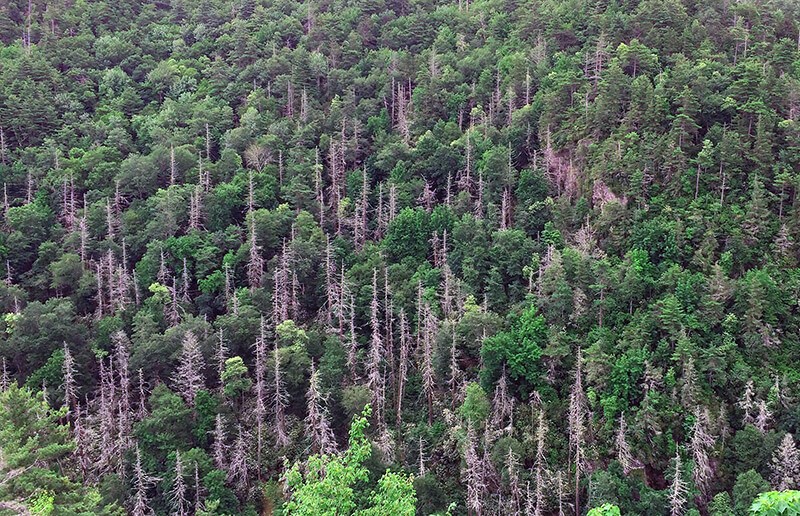
WEST LAFAYETTE, Ind. – Invasive insects and pathogens have wreaked havoc on ash, elm, chestnut trees and others, wiping some of them almost completely from American forests. In addition to the ecological impact, a Purdue University study shows that the carbon storage lost to these pests each year is the same as the amount of carbon emitted by 5 million vehicles.
Songlin Fei, a professor in the Department of Forestry and Natural Resources, said the trees killed each year by the 15 most invasive pests contain 5.53 teragrams of carbon (TgC), equivalent to about 6 million U.S. tons. His findings were published Monday (Aug. 12) in the Proceedings of the National Academy of Sciences.
“Not all of those dead trees immediately become carbon sources, but they are being taken away from the live biomass, which functions as carbon sink. Part of the dead biomass will eventually get into the atmosphere,” Fei said.
The losses are especially concerning as some have suggested forest carbon sequestration might fight climate change by capturing and retaining more of the carbon from the atmosphere. Fei said losses due to invasive species could damage those hopes.

“If we are thinking of forests as a tool to mitigate climate change, the tool itself is being challenged by these invasive pests,” Fei said. “Not only is the tool damaged, but also it’s becoming an impediment.”
Fei and colleagues from the U.S. Forest Service analyzed 10 years of forest surveys covering 93,000 field plots in the contiguous United States. They measured tree loss due to invasive pests – above and beyond natural tree deaths – for the most harmful pathogens and insects tracked by the Forest Service.
HTIRC Scientists Participate in Summer Research Program
By Dr. Shaneka Lawson
This past summer two interns from the Research Education and Extension for Undergraduates (REEU) program worked on a butternut research project with Dr. Shaneka Lawson and Jim McKenna. These summer interns were tasked with creating an independent summer research project that focused on trees. Dr. Lawson was the assigned faculty mentor and Jim McKenna provided extensive technical support and firsthand knowledge of the research site. After a meeting with HTIRC staff member Jim Warren, and a perusal of the HTIRC strategic plan, the interns chose to embark on a journey into the world of butternut (Juglans cinerea). Over the course of the 8-week program the interns performed basic literature reviews, collected field data, and developed four key deliverables. They generated a poster and PowerPoint of their research, a manuscript, and put together an extension/outreach activity that showcased butternut trees and helped those unfamiliar with the tree learn more about it in a fun manner. The summer interns stated they would like to further their interest in trees and are both looking for future career options in the field.

Here are video comments by the interns regarding the summer program: https://youtu.be/6CLhc6QTo0I
HTIRC Releases the First Annual Report

The first annual report of the Hardwood Tree Improvement and Regeneration Center was released in July, 2019. The report highlights the activities of the HTIRC for the 2018 calendar year. Several pages of the report are dedicated to the seven research projects funded by a competitive grant process designed to address the goals of the strategic plan. Information on the HTIRC research team, stakeholders, and advisory committee are included, as well as reports from the co-directors and updates on continuing programs, including the tree breeding efforts, extension and engagement, and education.
This is the first of what is planned to be regular annual reports providing an overview of HTIRC activities. The full report can be viewed at https://htirc.org/annual-report/
HTIRC Student and Staff Awards
Graduate Awards
Charles H. Michler Scholarship – Geoff Williams
Fischer Forestry Fund Graduate Student Scholarship – Madeline Montague
Purdue FNR Research Symposium
MS/Engagement – Caleb Redick (First Place)
PhD/Research – Geoff Williams (First Place)
2019 Faculty Awards
W.S. Cooper Award – Dr. Songlin Fei
HTIRC Graduate students who completed their thesis.
David Mann, M.S. Title of his thesis: Effects of Prescribed Fire on Tree Quality and Value in the Central Hardwood Region.
Caleb Redick, M.S. Title of his thesis: Quantifying Impacts of Deer Browsing and Mitigation.
Access HTIRC Research and Management Publications at our Website
Visit the HTIRC website at www.HTIRC.org to access the research publications produced in 2019 to stay up-to-date with the work of HTIRC scientists. Over 30 publications have been posted this year. You can also read and download the landowner and land manager publications aimed at establishment and management of hardwood trees. When you visit our website, click on the “Resources” tab at the top of the page to find our publications and newsletter or follow this link: https://htirc.org/resources/
